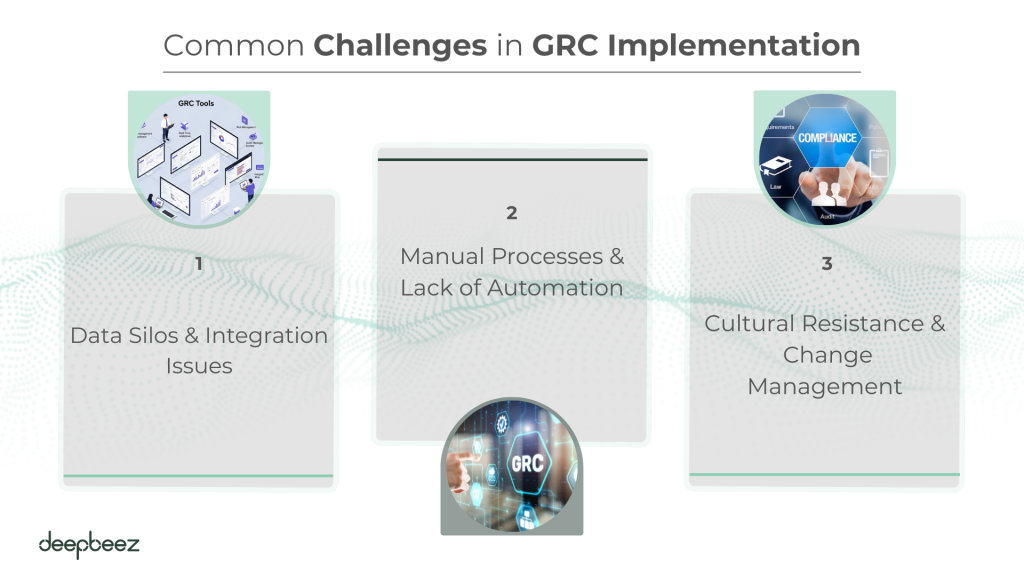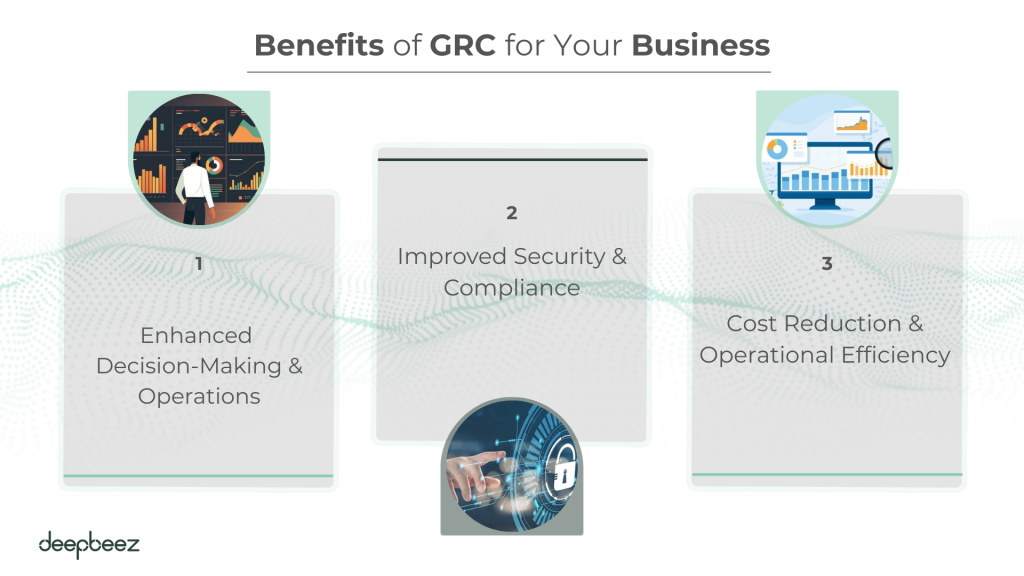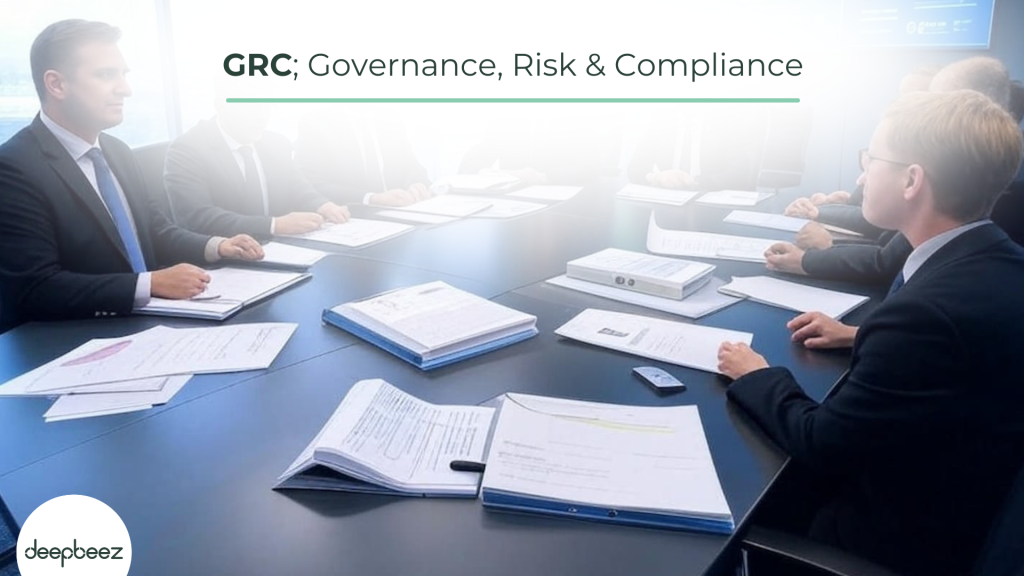GRC stands for Governance, Risk, and Compliance – three critical areas that every organization must manage effectively. Rather than handling these areas separately, GRC brings them together into one coordinated approach. Organizations developed this concept in the early 2000s when they realized the benefits of aligning these three crucial functions.
It refers to an organization’s strategy or a structured approach for managing the interdependencies among these three components. The goal of GRC is to align IT with business goals, manage risks, and meet all industry and government regulations
Have you ever wondered how large organizations manage to stay on top of all their policies, risks, and regulatory requirements? The answer lies in GRC – a powerful framework that’s transforming how businesses operate in today’s complex world.
What Is GRC?
Think of GRC as the backbone that helps companies act ethically while achieving their business goals. It reduces inefficiencies and improves communication by breaking down silos between departments. By coordinating processes, technologies, and people, GRC creates a framework that ensures everyone is working toward the same objectives.
Does your organization struggle with coordinating different departments? GRC might be the solution you’re looking for!
What Is the Core Principles of GRC?
At its heart, GRC is about integration and coordination. Let’s break down the three pillars that make up this powerful framework:
| GRC Principle | Primary Focus | Key Benefits |
| Governance | Setting policies and ethical frameworks | Accountability, resource control, ethical culture |
| Risk Management | Identifying and mitigating threats | Business continuity, informed decisions, reduced vulnerabilities |
| Compliance | Following rules and regulations | Legal protection, penalty avoidance, industry credibility |
Governance
Governance forms the foundation of your organization’s ethical structure. It includes the policies, rules, and frameworks that guide your business activities and ensure they align with your goals. Good governance defines responsibilities, maintains control of resources, and enforces ethical business practices.
When you implement strong governance, you empower your employees while ensuring accountability throughout the organization. It’s about creating a culture where ethical decisions come naturally because everyone understands the expectations and values of the company.
Risk Management
How does your organization handle uncertainty? Risk management involves identifying, evaluating, and managing various risks that could impact your operations. This includes legal, financial, strategic, and security-related risks that might threaten your business.
Effective risk management establishes clear objectives for mitigating threats. It keeps stakeholders informed and incorporates legal, contractual, and business requirements into your risk strategies. A comprehensive risk management program identifies security threats, assesses their potential impact, and implements mitigation plans to ensure business continuity.
Compliance
Compliance ensures your organization follows all necessary rules – both internal and external. This includes government regulations, industry standards, and your own company policies. Failing to comply can result in serious legal and financial penalties.
Successful compliance management integrates both external requirements (like industry standards and laws) and internal policies. Organizations must regularly update compliance policies and provide adequate employee training to maintain compliance in an ever-changing regulatory landscape.
Do you see how these three principles work together to create a stronger organization? When integrated properly, they reduce costs, improve security, enhance operational efficiency, and increase transparency. The magic happens at their intersection!
Common Challenges in GRC Implementation
Implementing GRC isn’t always smooth sailing. Let’s explore some typical challenges organizations face:

1- Data Silos and Integration Issues
Without proper integration, GRC implementation can actually worsen data silos instead of eliminating them. When departments continue working toward individual goals without considering the bigger picture, your GRC strategy might fail to provide the unified view needed for informed decision-making.
Cross-enterprise coordination is essential for breaking down these silos. Your organization needs a comprehensive framework that brings different departments together under a shared understanding of goals and processes.
2- Manual Processes and Lack of Automation
Are you still relying heavily on manual processes? This can lead to wasted time and human error. Many organizations struggle with inefficiencies and have difficulty locating required documentation when processes aren’t automated.
Without automation, your visibility into data monitoring and collection becomes limited. Modern GRC implementation typically includes technology solutions that automate routine tasks and streamline workflows, freeing up your team to focus on more strategic activities.
3- Cultural Resistance and Change Management
One of the biggest hurdles in GRC implementation is organizational culture. Without commitment and support throughout the organization, your GRC strategy may struggle to gain traction. Continuously updating and maintaining the framework requires ongoing effort from all stakeholders.
Change management becomes particularly challenging in fast-changing business environments. Companies need to invest in programs that help them act quickly based on GRC insights, but they often face resistance from employees who are reluctant to change their work habits.
| Challenge | Impact | Potential Solution |
| Data Silos | Fragmented insights, poor decision-making | Integrated GRC platform, cross-functional teams |
| Manual Processes | Errors, inefficiency, limited visibility | Automation, GRC software implementation |
| Cultural Resistance | Implementation failure, poor adoption | Leadership support, training, clear communication |
What challenges do you anticipate in your organization? Identifying them early can help you prepare effective strategies to overcome them.
Benefits of GRC for Your Business
GRC offers numerous advantages that can transform how your organization operates. Let’s explore the key benefits:
| Benefit | Business Impact | Stakeholder Value |
| Better Decision-Making | Faster, more informed choices | Strategic advantage, reduced errors |
| Enhanced Security | Protected data, fewer breaches | Customer trust, brand protection |
| Reduced Costs | Lower operational expenses | Improved profitability, resource optimization |
1- Enhanced Decision-Making and Operations
When you implement GRC, you gain a unified view of data insights across your organization. This enables you to make better, data-driven decisions in less time. By bringing different parts of the business into a coordinated framework, you create a foundation for more responsible operations.
GRC helps you streamline activities around a common culture that promotes ethical values. It guides the development of a strong organizational culture and fosters an environment where growth happens naturally. When everyone works within the same ethical framework, your business goals become more achievable.
2- Improved Security and Compliance
In today’s digital landscape, cybersecurity threats loom large. An integrated GRC approach enables you to employ robust data security measures to protect customer information and private data. This is especially crucial for organizations facing increasing cyber risks.
GRC helps you comply with data privacy regulations like GDPR, building customer trust while protecting against penalties. With increased visibility into risks, threats, and vulnerabilities, you can secure your infrastructure from various threat vectors and maintain ongoing compliance with required standards and regulations.
3- Cost Reduction and Operational Efficiency
One of the most tangible benefits of GRC is cost reduction. By eliminating redundant processes, resources, and tools, you simplify operations and decrease waste of time and money. A well-planned GRC strategy addresses inefficiencies associated with siloed approaches to risk and compliance.
GRC enables your organization to gather information quickly and accurately, reduces duplication of efforts, and automates routine tasks. This enhanced operational efficiency allows your team to focus on strategic initiatives rather than administrative tasks.

Different Types of GRC Approaches
There isn’t a one-size-fits-all solution when it comes to GRC. Let’s explore the different approaches available:
| GRC Type | Focus | Best For |
| Integrated GRC | Comprehensive coverage | Large organizations with complex needs |
| Targeted GRC | Specific departments/functions | Organizations with distinct priority areas |
| Point-Solution GRC | Single aspect of GRC | Focused needs with limited resources |
1- Integrated GRC
Integrated GRC uses comprehensive software that provides an enterprise-wide view of governance, risk, and compliance. This approach combines applications to manage core GRC functions within a single, unified platform.
With integrated GRC, you gain a holistic view of your organization’s risk landscape and compliance status. This comprehensive approach works particularly well for large organizations with complex regulatory requirements and operations spanning multiple departments or locations.
2- Targeted GRC
Unlike integrated approaches, targeted GRC focuses on specific areas within your organization. These tools address the unique GRC needs of particular departments or functions, such as IT, finance, or business risk.
Targeted GRC can be an excellent starting point for organizations new to GRC or those with limited resources. By focusing on high-priority areas first, you can gradually expand your GRC implementation while gaining valuable experience and demonstrating success.
3- Point-Solution GRC
Point-solution GRC tools target a single aspect of GRC rather than covering all three components comprehensively. These specialized tools might focus exclusively on compliance management, risk assessment, or governance policies.
While less comprehensive than integrated approaches, point solutions can provide deep functionality in specific areas. They’re often more affordable and easier to implement, making them attractive for organizations with well-defined, limited GRC needs.
Which approach seems most suitable for your organization’s current stage and needs? Remember that your GRC strategy can evolve over time as your organization matures. Additionally, you’ll need to consider hosting options:
- On-Premises GRC: This involves hosting the GRC platform on the company’s in-house IT infrastructure and servers.
- Cloud-Based GRC: This involves relying on a vendor’s servers to host GRC applications, which are then accessible from various locations and devices.
Is It Necessary to Implement GRC?
GRC represents more than just a set of policies or technologies – it’s a transformative approach that can revolutionize how your organization operates. By integrating governance, risk management, and compliance into a coordinated framework, you create a foundation for ethical behavior, efficient operations, and sustainable growth.
Remember that successful GRC implementation requires clear goals, leadership support, appropriate technology, and a supportive organizational culture. While you may face challenges along the way, the benefits – including improved decision-making, enhanced security, reduced costs, and better compliance – make the journey worthwhile.
I encourage you to assess your organization’s current approach to governance, risk, and compliance. Where do you see opportunities for better integration? What challenges might you face in implementing a comprehensive GRC framework? By addressing these questions proactively, you’ll be well on your way to realizing the full potential of GRC.
Are you ready to transform your organization with GRC? The journey starts with a single step – whether that’s securing leadership buy-in, assessing your current state, or exploring potential technology solutions. Where will you begin?
FAQ
1- What is GRC and why is it important?
GRC stands for Governance, Risk, and Compliance. It’s a structured approach to align IT with business goals while managing risks and meeting industry and government regulations. Companies use GRC to achieve organizational goals reliably, remove uncertainty, and meet compliance requirements.
2- What are the biggest challenges faced by GRC teams?
GRC teams face several significant challenges, including an evolving regulatory landscape that requires constant adaptation to new rules and standards. Quora According to research, 57% of senior executives ranked risk and compliance as one of the two categories they feel least prepared to address.
3- How do you implement a new regulatory requirement across an organization?
Effective implementation requires thoroughly studying the requirement, understanding its scope and objectives, and then developing a clear plan for organization-wide adoption.
4- How can organizations address data privacy complaints from a GRC perspective?
From a GRC standpoint, addressing data privacy complaints involves conducting a thorough review of data privacy policies, assessing data handling practices for compliance, identifying gaps in controls, implementing corrective actions, and monitoring effectiveness.
5- What is the relationship between GRC and incident response?
Effective GRC practices strengthen incident response by establishing governance frameworks that define how incidents should be handled, risk management processes that identify potential vulnerabilities, and compliance measures that ensure responses meet regulatory requirements.
6- Why do organizations struggle with GRC implementation?
Organizations often struggle because GRC requires cross-functional collaboration across departments that traditionally operate in silos. This results in duplicate data and introduces challenges in managing information effectively.
7- What skills are most important for GRC professionals?
GRC professionals need strong analytical skills, knowledge of relevant regulations, communication abilities to translate complex requirements, project management expertise, and technical proficiency with GRC tools and frameworks.
8- How do you measure the effectiveness of a GRC program?
Governance effectiveness can be measured through key performance indicators such as financial performance, customer satisfaction, and employee engagement.
9- What is the role of technology in GRC?
GRC software helps gather and analyze records, determine inefficiencies, support organization-wide implementation, collect feedback, report incidents, and provide robust reporting for improved decision-making.
10- How should organizations approach GRC in cloud environments?
Cloud adoption presents unique GRC challenges including data transfer to third parties, contractual considerations, and shared security responsibilities. Organizations should develop cloud-specific governance policies, assess cloud provider compliance, and implement appropriate controls.
11- What is the relationship between GRC and cybersecurity?
GRC provides the framework for cybersecurity governance, risk assessment, and compliance with security standards and regulations. Effective GRC practices ensure cybersecurity efforts align with business objectives and regulatory requirements.
12- How can small businesses implement GRC without extensive resources?
Small businesses can implement GRC by focusing on core risks, using scalable GRC tools, developing simple but effective policies, leveraging external expertise when needed, and gradually building their GRC program as the organization grows.
13- What certifications are valuable for GRC professionals?
The GRC Professional (GRCP) certification ensures understanding of the OCEG GRC Capability Model, which is independent of a specific profession or vendor solution. The GRC Audit Certification (GRCA) is valuable for those who audit GRC activities.
14- How does poor governance impact an organization?
Poor governance can result in reputational damage, financial loss, and regulatory non-compliance.
15- What should organizations consider when selecting GRC software?
Organizations should seek a single solution for all GRC requirements to avoid the complexity of managing different technologies with different data formats.
16- How are GRC practices evolving with new technologies?
GRC practices are adapting to address challenges from AI, automation, and digital transformation. Evaluating new technologies requires conducting ethics impact assessments, ensuring alignment with regulations, establishing clear governance measures, and implementing ongoing monitoring.





